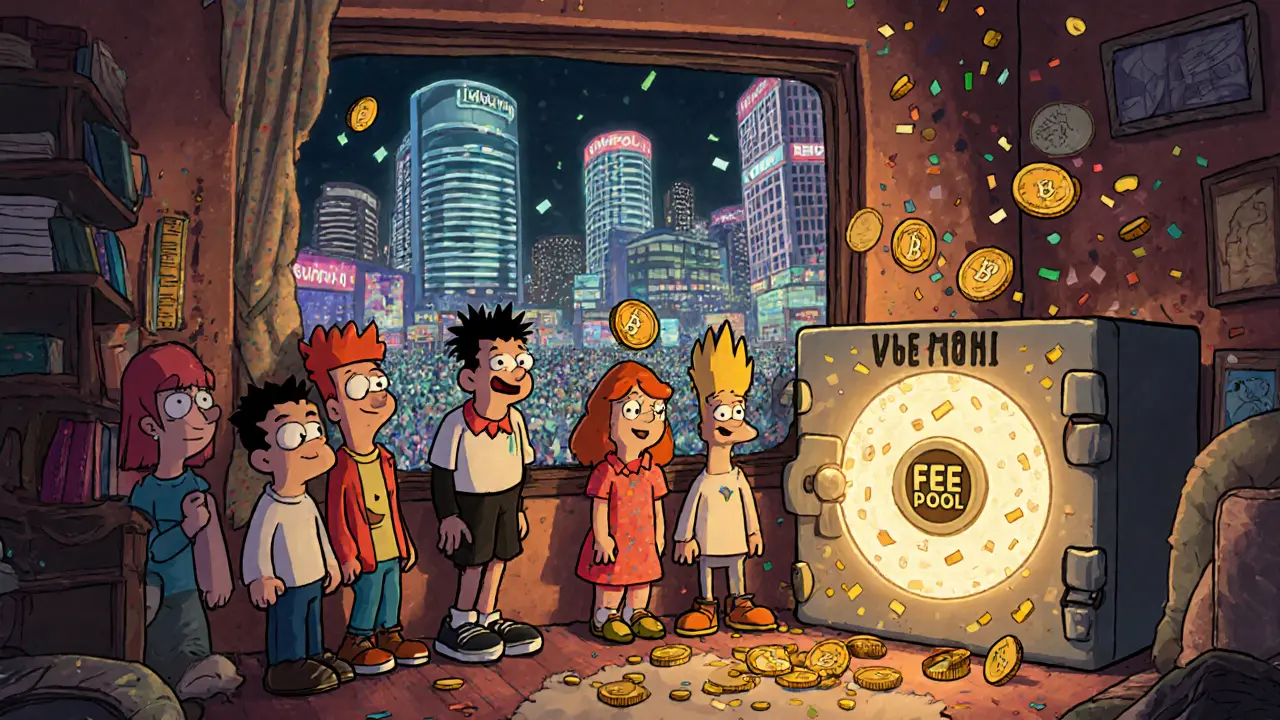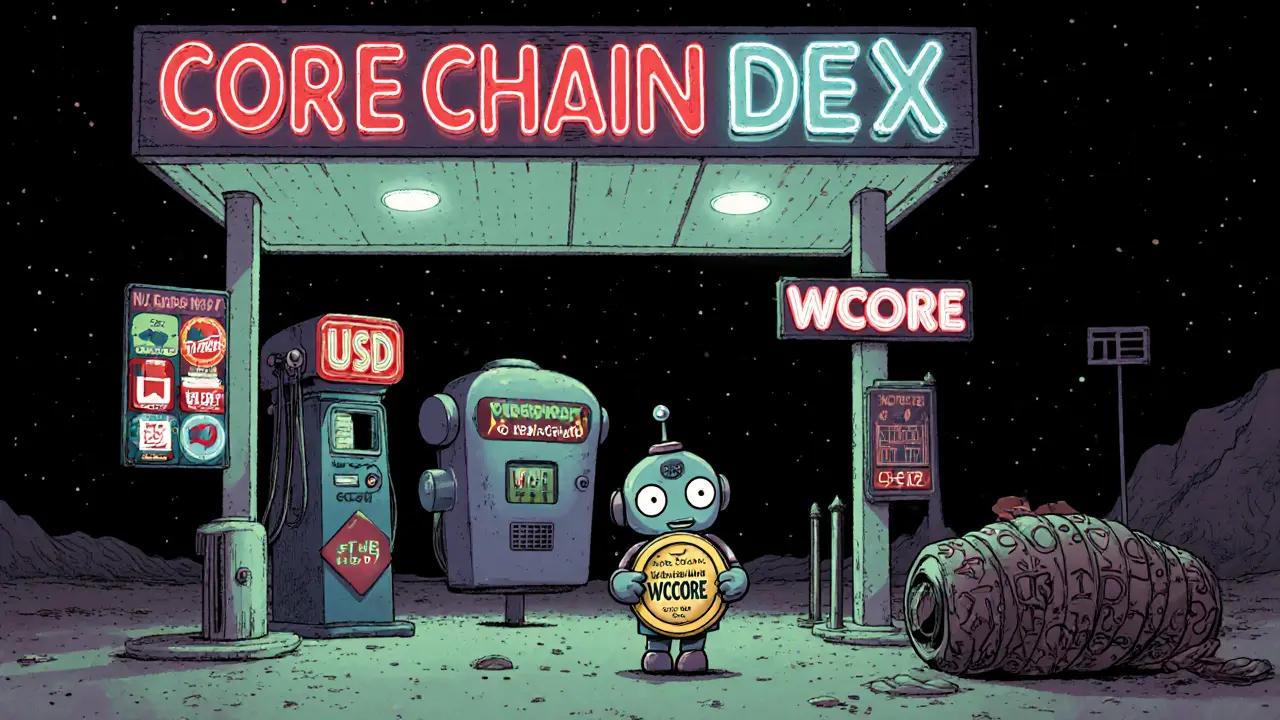VOLT Staking Earnings Calculator
VoltSwap offers single-sided staking for VOLT tokens. Hold VOLT and earn a share of trading fees without providing liquidity. The platform distributes 90% of fees as rewards to stakers.
Current data (as of October 2025): 24h Volume: $6.02 VOLT Price Range: $0.0002015 - $0.0002413 Circulating Supply: 53.87M VOLT
Most crypto traders know the pain of front-running - when bots snatch your trades before you even see the price move. It’s not just annoying; it eats your profits. That’s why VoltSwap exists. Built on the Meter blockchain, it promises to be the first fully front-running resistant cross-chain DEX. But does it deliver? Or is it just another niche project with big claims and tiny volume?
What Is VoltSwap Really?
VoltSwap isn’t another copy of Uniswap or PancakeSwap. It’s a decentralized exchange built specifically for the Meter blockchain. Launched as "The Layer 2 swap for the people," it’s designed to be fast, cheap, and immune to the sneaky bots that ruin trades on other DEXes. Unlike centralized exchanges like Binance or Coinbase, VoltSwap has no middleman. You trade directly from your wallet using smart contracts.
The whole platform runs on the VOLT token - its governance and revenue-sharing coin. There are 100 million VOLT tokens total. As of October 2025, about 53.87 million are already in circulation. That means nearly half the supply is still locked up, waiting to be released over time through farming rewards. This isn’t a pump-and-dump setup. The team designed it to incentivize long-term participation, not quick flips.
How VoltSwap Stops Front-Running
Front-running is a huge problem on Ethereum-based DEXes. Bots monitor the mempool - the queue of pending transactions - and jump ahead of yours to buy low and sell high. VoltSwap solves this with a unique architecture on Meter’s Layer 2. Instead of broadcasting trades publicly, it uses a private order matching system. Transactions aren’t visible until they’re confirmed. No one can see your order before it executes. That means bots can’t react in time.
This isn’t just marketing talk. It’s built into the protocol. Every trade goes through a sealed-bid mechanism where prices are locked in before execution. You know what you’re getting. No surprises. No slippage from bots. That’s rare. Even top DEXes like Uniswap V3 still struggle with this on high-traffic pairs.
VOLT Token: More Than Just a Governance Coin
VOLT isn’t just for voting. It’s your ticket to passive income. Holders earn a share of VoltSwap’s trading fees - no liquidity provision needed. That’s called single-sided staking. You don’t have to pair your VOLT with another token. You don’t risk impermanent loss. You just hold, and you get paid.
Here’s how it breaks down: 90% of the total VOLT supply is allocated to farming rewards over four years. That’s a massive incentive to stick around. The remaining 10% covers team, treasury, and ecosystem development. As of October 2025, the token trades between $0.0002015 and $0.0002413. That’s down 99.9% from its all-time high of $0.2352 in January 2022. But here’s the twist: it’s up 58.7% from its April 2025 low of $0.0001521. And over the past week, VOLT gained 13.5% while the broader crypto market dropped 2.1%.
That’s not a bubble. That’s a signal. A small one, but real. The trading volume is still tiny - just $6.02 in 24 hours. But it jumped 285% from the day before. That’s the kind of volatility you see when a sleepy project wakes up.

Trading on VoltSwap: What You Need
To use VoltSwap, you need two things: a Web3 wallet (like MetaMask or WalletConnect) and MTRG tokens. MTRG is Meter’s native token. You need it to pay for gas - yes, even on a Layer 2, you still need gas. But it’s cheap. Like, 100x cheaper than Ethereum.
The interface is simple. Connect your wallet. Pick a pair. Swap. You can trade VOLT/MTRG directly on the platform. That’s the most active pair. You won’t find VOLT on Binance, Coinbase, or KuCoin. It’s only listed on VoltSwap itself and a few tiny exchanges. That limits liquidity. But it also means you’re not competing with big players. The market is quiet - which can be good or bad, depending on your strategy.
If you’re looking to do large trades, VoltSwap isn’t for you. The depth is shallow. But if you’re swapping small amounts - say, $50 or $100 - and you care about privacy and fairness, it’s one of the few places where you won’t get sandwiched.
How VoltSwap Compares to Other DEXes
Let’s be clear: VoltSwap doesn’t compete with Uniswap or SushiSwap on volume. It doesn’t even come close. Uniswap moves billions daily. VoltSwap moves dollars.
But it competes on something else: fairness.
| Feature | VoltSwap | Uniswap V3 | PancakeSwap |
|---|---|---|---|
| Blockchain | Meter (Layer 2) | Ethereum | Binance Smart Chain |
| Front-running protection | Yes | No | No |
| Gas fees | ~$0.001 | $5-$50+ | $0.10-$2 |
| Staking rewards | Single-sided (VOLT only) | Requires LP tokens | Requires LP tokens |
| 24h volume (Oct 2025) | $6.02 | $1.2B | $450M |
| Token utility | Governance + fee sharing | None (UNI is governance only) | Governance only |
VoltSwap wins on fairness and cost. It loses on liquidity and name recognition. If you’re tired of paying $20 in gas to swap $100 of ETH, and you want to avoid bots, VoltSwap is one of the few options that actually delivers.

Who Is VoltSwap For?
It’s not for everyone. If you’re trading large sums, you need deep liquidity. VoltSwap doesn’t have that. If you want to buy VOLT as a speculative play hoping for a 100x, you’re playing Russian roulette with a loaded gun. The market cap is tiny. One whale could wipe out your position.
But if you’re a privacy-focused trader who hates front-running? If you believe in Meter’s tech and want to support a truly community-run project? If you’re looking for a low-cost, fair way to swap small amounts of crypto without paying $10 in fees? Then VoltSwap is worth a look.
It’s not a replacement for your main exchange. It’s a tool. A specialized tool. Like a Swiss Army knife with one perfect blade. You don’t use it for everything. But when you need it - you really need it.
Is VoltSwap Safe?
It’s decentralized, so no one can freeze your funds. No KYC. No account holds. That’s good. But it also means no customer support. If you send tokens to the wrong address? Gone forever. If the smart contract has a bug? The community has to fix it. There’s no company behind it.
The code is open-source. Audits have been done, but not by the big names like CertiK or Trail of Bits. That’s a red flag for some. For others, it’s just a sign the project is small and underfunded - not malicious.
Security-wise, it’s as safe as any DEX built on a live blockchain. Meter has been running since 2020. No major exploits. The Layer 2 design adds another layer of protection. But you’re still responsible for your own keys. Always.
What’s Next for VoltSwap?
The future depends on two things: Meter adoption and VOLT demand.
Meter is still a small chain. It doesn’t have the developer tools, the wallets, or the DeFi apps that Ethereum or Solana have. But it’s growing. The team is working on better integrations with other chains via Meter Passport. If that works, VoltSwap could become a bridge for cross-chain swaps without the usual slippage and delays.
And VOLT? If more people start using VoltSwap, the fee pool grows. That means more income for stakers. That could attract more holders. That could create a positive loop. But it’s a chicken-and-egg problem. No volume → no rewards → no users → no volume.
Right now, it’s quiet. But the recent price and volume spike suggest someone is starting to notice. Maybe it’s early. Maybe it’s too late. But if you believe in fair trading and low fees, VoltSwap is one of the few places trying to fix what’s broken.
Is VoltSwap a scam?
No, VoltSwap is not a scam. It’s an open-source, community-run DEX with transparent tokenomics. The code is public, and there’s no evidence of rug pulls or hidden team wallets. However, the project is small, with minimal liquidity and low trading volume, which makes it risky for speculative trading. Always do your own research before investing.
Can I stake VOLT without providing liquidity?
Yes. VoltSwap offers single-sided staking for VOLT tokens. You don’t need to pair them with MTRG or any other asset. Just hold VOLT in your wallet, stake it on the platform, and earn a share of trading fees. This avoids impermanent loss, which is a major risk in traditional liquidity pools.
Why is VoltSwap’s trading volume so low?
VoltSwap’s volume is low because it’s built on the Meter blockchain, which has limited adoption compared to Ethereum or BSC. Most traders use larger DEXes for better liquidity and more token options. VoltSwap’s niche is front-running resistance and low fees - not volume. Its recent 285% volume spike suggests growing interest, but it’s still a micro-cap project.
Do I need MTRG to use VoltSwap?
Yes. You need MTRG tokens to pay for gas fees on the Meter blockchain. Even though VoltSwap is a Layer 2 solution, it still relies on Meter’s base layer for final settlement. You can buy MTRG on exchanges like Gate.io or directly through VoltSwap’s bridge feature.
Is VoltSwap taxable?
Yes. All crypto trades on VoltSwap are taxable events in most countries, including the U.S. Since it’s a decentralized exchange, there’s no KYC or reporting - but you’re still legally required to track your trades and report capital gains or losses. Use crypto tax tools like Koinly or TokenTax to calculate your liability.
Can I buy VOLT on Coinbase or Binance?
No. VOLT is not listed on any major centralized exchanges. You can only buy it on VoltSwap itself (using MTRG) or on a few small decentralized exchanges that support the Meter blockchain. This limits accessibility but keeps the token ecosystem isolated and community-controlled.


